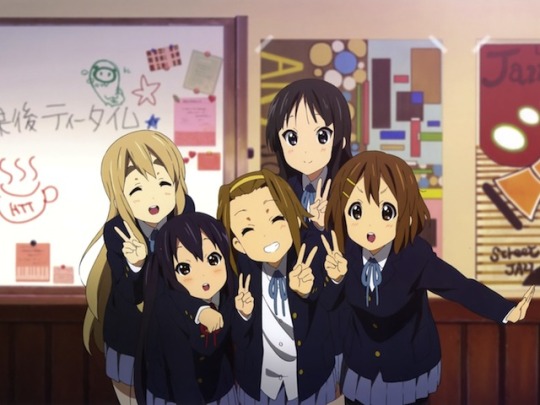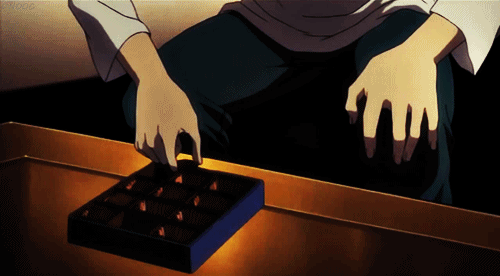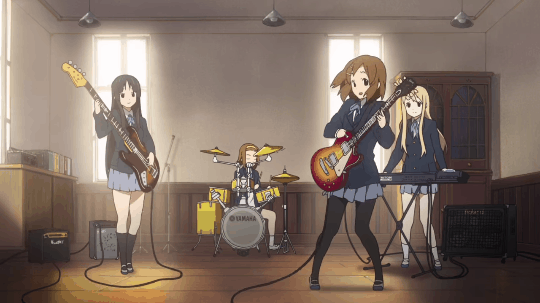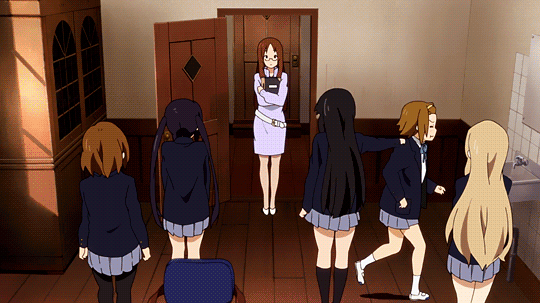Text
K-On!: Music through cherished friendships

I’ve been watching anime since high school, thanks to the influence of my sister and my high school friends. I would enter Comic Alley, an anime merchandise store in the Philippines, and see interesting merch of animes I’ve never watched — some are familiar to me, such as Slam Dunk (as we have a poster of this back in our old home). Nothing is memorable as Death Note, my first anime that I’ve watched, made me hooked with everything, including L (Lawliet).

Watching anime gave me comfort, to the point where I almost forgot that I still live in reality. Everything in an anime is just pretty, comical, and unconsciously teaches you that life can still be appreciative. I’d remember my weekend mornings preparing Lucky Me Jjamppong (짬뽕) for breakfast - to pretend to be in the shoes of the Japanese characters (lol okay my connotation of Japan was cup noodles... even though 짬뽕 is actually Korean noodles, pardon my ignorance) then turning on my laptop to watch anime.
My favorite anime theme is school and music. These two themes combined is the key to easy influence. As I consulted my anime/manga friend enthusiast, she told me it’s a classic. I can’t wait to hear anime music again, reminded me of Girl DeMo (Girl Dead Monsters) from Angel Beats, where until now I continue to listen to the entire album.

It’s been a while since I last watched an anime. Life just happens in a flash and I completely forgot the comfort of watching anime. With the current chapter of my life right now, I discovered K-On! on Netflix (thank goodness it’s subbed) once I saw the characters holding musical instruments.

K-On! ( けいおん) is a slice-of-life anime of high school girls who are in a music club who does their best to not lead to disbandment. Yui, a clueless high school student who doesn’t know what club to join, stumbled into Light Music Club, where she became the awaiting member to save the club from disbandment, even without the lack of knowledge in music, eventually became an excellent guitar player.
Yui, Mio, the shy bassist player; Mugi the rich down-to-earth keyboard player who prepares fancy tea and cakes, and Ritsu the chill yet loyal drum player and later on Azusa, the passionate guitar player, became the image of Light Music Club. The five of them write their own songs and gives an A+ performance and would oftentimes slack in their club room having tea and do other miscellaneous activities. However, they are able to make meaningful friendships with one another and knows how important it is to look for one another. They would do part-time jobs to buy Yui’s guitar, help Mio’s anxiety, let Mugi explore normal activities, help Ritsu with burn out, and think of Azusan’s welfare by providing a pet turtle. They also have their homeroom teacher, Sawako, who is a former Light Music Club member, with a lady-like image but behind is a rock guitar player at heart — supports the girls with their music.
While the students from their school know that they don’t practice as often as a music club should, in the end, they never fail to blow a fantastic performance. My top two songs from them are Love is like a Stapler and Fude Pen.

I’m torn between two characters choosing who is my favorite one, but I guess I like them from different perspectives. I’m going to break it down two Mugi and Azusa.

I can relate to Azusa on a personal level. She’s passionate about music (as she prefers to practice than playing along with the club’s slack), looks up to maturity, and hesitant to admit her feelings. Azusa tries to be mature in ways she knows how, but like humans, she also has weaknesses (cake, lol). She’s also inquisitive, which helps her discover her purpose.
I’m fond of Mugi. Despite her wealthy background, she finds joy in small things. I’ve never been so happy watching her find joy in doing “normal activities”: work in a part-time job, eating in a fast-food restaurant, learning to haggle, discovering a store that sells cheap candies, and playing in an arcade. I find it very humbling, especially when she enjoys making tea and preparing confectionaries for her friends.
This anime gives a nice companionship of showing innocent friendships as a reminder of how loyalty and bonding are friendships worthy to be treasured.
1 note
·
View note
Text
Connecting Filipino mainstream and indie viewers through Philippine Cinema
This September 12, 2019 hails the 100th year for Philippine Cinema, the birth of the very first Filipino film ‘Dalagang Bukid’ (1919) by José Nepomuceno. Since then, Filipino filmmakers have reached its own successes locally and internationally such as: Lino Brocka as the first entry Filipino filmmaker at Cannes Film Festival, Ishmael Bernal winning home nine-major awards for ‘Himala’ at Metro Manila Film Festival, and Marilou Diaz-Abaya’s award of Arts and Culture prize at the Fukuoka Asian Culture Prizes— take pride for representing Filipinos through cinema – as their films share themes of melodrama, oppression, and politics due to censorship during the Martial Law. Up to this day, Filipino filmmakers continue to pave their way through reaching international recognition for their craft: Erik Matti’s ‘On the Job’ (2013), Mikhail Red’s ‘Birdshot’ (2016), and Shireen Seno’s ‘Nervous Translation’ (2017). Philippine Cinema has evolved from creating films of heroism to comedy; post-war era involves sci-fi and fantasy, rise of erotic films, action films, until settled to Philippine modern cinema in the late 1980s, where recyclable yet predictable storylines are used especially centered in romance. This has started the foundation of mainstream in Philippine Cinema.
Filipino masses have already laid their eyes on romance-comedy films; as this genre brings more profit which is why it’s a production company’s favorite to produce. Beside the favorite genre, Filipinos still cherish a family-themed movie that embodies the character of a Filipino family. Romance-comedy and family-oriented themes become an escapism for Filipinos from living in the reality in the Philippines. A Filipino mainstream film is mostly romance-comedy or family-themed genres that contain cliché plotlines, utilization of famous actors, frequent use of ‘love teams’, and usage of cheesy punch lines. However, an example of a mainstream film “Four Sisters and a Wedding” (2013) directed by Cathy Garcia-Molina – one of the known directors in Filipino mainstream cinema – lasted a long impression to Filipinos. A mainstream movie in the Philippine setting has a division of audiences between mainstream and indie, but as for this film, it has captured both audiences and became iconic given its release six years ago.
Four Sisters and a Wedding is a film about the youngest child in the family who is about to get married and has four older sisters planning to stop the wedding. Given the synopsis, it’s considered as a typical Filipino comedy film. Most have memorized the entire script from their favorite scene in the film because for Filipinos, striking dialogues are often used as punch lines for comic relief. Regardless of political and social tension in the country, people would throw out references from the movie and turn it into memes and bring awareness of social issues, also reflecting the personal political views of the actors. The movie portrays the true character of a Filipino family: Teddie, the eldest, flew to Spain for her teaching career and master’s degree until caught in Spain’s crisis, ended up doing part-time jobs and not tell the truth; Bobbie, the smartest sibling, scored a corporate job in New York; Alex, the ‘Black Sheep’ lives in her own car while working in film; Gabbie, a public school teacher with low salary pay takes care of their mother and the youngest, CJ, the 22-year old who is about the get married. While the older sisters are planning to sabotage CJ’s wedding, it is revealed that there is a bigger problem (unresolved internal family problems) than the wedding itself. This movie didn’t fail to picture the means of being in a Filipino family: envy between siblings, favoritism, sacrificial love for the family’s future, monitoring the ‘bunso’ (youngest child) and looking out for one another – are most of the elements that capture a Filipino family – still able to create relatable characters that hit Filipinos on the right spot and represent an identity in a comedic manner. These common qualities are also present in most Asian families: not being a disgrace, raising family status, and concealing your inner struggles.
While it holds on with the intention of showing Filipino values, the movie itself still sticks with the formula of a mainstream Filipino movie. This concept causes a division on the Filipino audience as it argues depth and appeal on the film, turning into a reflection of the kind of person he/she is. It creates a stereotype where if one enjoys watching mainstream movies is considered uncultured or jologs as to someone who watches indie movies is stereotyped as too intelligent, bourgeois, or hipster. The audience for watching Filipino films are mostly by class, an analogy would be mainstream equates to masses since it contains themes of romance, comedy, and action – anything light-hearted that relieves stress; thus these films are mostly screened on shopping malls – as opposed to indie equates to art house, experimental, or short films that mostly covers themes of oppression, sex, poverty, and sensitive issues – which are themes that masses avoid to be reminded of the hardships they are going through. Indie films are often screened in independent local film festivals and anticipated by either college students or general film enthusiasts. However in this film, both mainstream and indie audiences found a common ground from impactful screenplay and its quirkiness that also connects them from their belongingness in a Filipino family.
A film like Four Sisters and a Wedding, that qualifies mainstream, is an example of how Philippine Cinema can come in unity – without the dichotomy of mainstream versus indie in terms of depth and appeal. Mainstream and indie would continue to stick to their own standard; however, Philippine Cinema must not be limited on one ideal standard. ‘Maindie’ is a new category in the Philippines where mainstream and indie standards are met. Cinema itself is simply telling a story across an audience that doesn’t restrict to the film’s classification. Regardless of how a film is made, it will always entail what Philippine Cinema has established from the beginning. Whether it’s mainstream, indie, or ‘maindie’, there is no clear distinction of what makes a good film; that would depend on the audience’s perspective and will always never reach their expectations but to only unify them under one cinema that brings together their ideals and culture as Filipinos.
(This is an essay that I submitted as our midterm paper in our Film Studies class. We were tasked to write anything we like relating to films, and I wanted to write a topic that I know I’ll never be tired of discussing)
0 notes
Text
Tan France’s Naturally Tan
There is more to Tan France than a french tuck.

It was not so long ago when Queer Eye aired on Netflix last February 2018. I’ve loved the show so much that I pledged myself to make my close friends love the show as much as I do. It worked. We love each of the Fab Five unconditionally.
After watching the first season, I wanted to know more about them. But after the first airing was the peak of their fame. You wouldn’t see a lot of their background on the internet during that time as they have just begun. While they were working on Queer Eye season 2, social media outlets start to introduce Fab 5. I would watch every single video that involves them. Til’ then, the Fab 5 is all over the internet.
While their show is a continuing success, I still continue low-key stalking on these guys. When I came across Tan France’s Wikipedia page, he only had a very brief background about him. There is no way these are the only things he has. I knew this guy has more to tell than being the fashion guy on the show.
There is something with Tan that I’m unsure of. I’m not gonna lie that my wardrobe is partly inspired by him. He mostly wears solid colors and jeans and still be able to look grounded and presentable. I knew that was the kind of style I want to articulate my personality.
“Clothes were the only way I knew how to articulate myself.” - Tan France, Naturally Tan (2019)
Opening the book, I had expectations of knowing how he started entering the fashion industry before Queer Eye. I expect to know his background up to his peak in Queer Eye. Surprisingly, I got more than I expect to know.
Tan became an open book. He doesn’t only talk about clothes. He talks more than clothes. He labels the chapters to clothing pieces that best represent his story. I had countless jaw drops whenever he starts to share his stories growing up in the UK, his sexuality while being in a Middle-Eastern household, aggressive racism he dealt with over the years and counting, his perception with relationships until he became committed with his husband Rob, and how he discovers himself more through rigid life experiences.
Naturally Tan stays true to the title. The way he (literally) became an open book shows no sugar coating, which is exactly what he wanted to portray on the show and media. The title states the obvious. His book is legitimately the authenticity you can get from him. Tan carried plenty of insights that must be read by not only Queer Eye fans, but to also youngbloods, clueless adults, and people who aspire to be in the fashion industry who wants to find someone to look up to.

“It’s amazing how people of colour can be some of the most racist people you’ll come across. It’s not because they fear or hate other people of color; it comes from a place of status and class, and how you don’t want your place to be misrepresented and from subconsciously assuming that white is “better” because there are greater opportunities for white people.” -Tan France, Naturally Tan (2019)
I’m one of the type of readers who take decades to finish a book (or never finish it at all), but it took me a week to finish as I couldn’t get enough of him.
119 notes
·
View notes